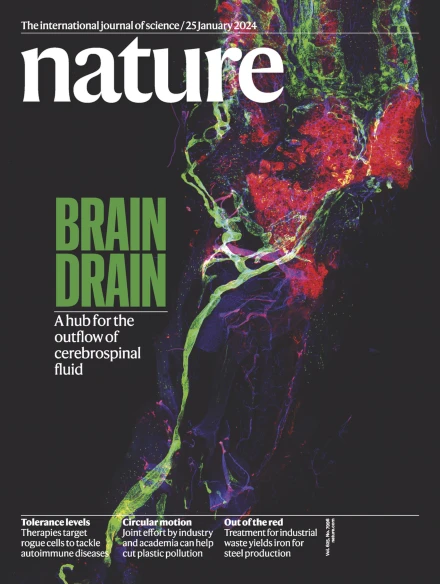A soft-clamped topological waveguide for phonons
IF 50.5
1区 综合性期刊
Q1 MULTIDISCIPLINARY SCIENCES
引用次数: 0
Abstract
Topological insulators were originally discovered for electron waves in condensed-matter systems. Recently, this concept has been transferred to bosonic systems such as photons1 and phonons2, which propagate in materials patterned with artificial lattices that emulate spin-Hall physics. This work has been motivated, in part, by the prospect of topologically protected transport along edge channels in on-chip circuits2,3. In principle, topology protects propagation against backscattering, but not against loss, which has remained limited to the dB cm−1 level for phononic waveguides, whether topological4–7 or not8–19. Here we combine advanced dissipation engineering20—in particular, the recently introduced method of soft clamping21—with the concept of valley-Hall topological insulators for phonons22–26. This enables on-chip phononic waveguides with propagation losses due to dissipation of 3 dB km−1 at room temperature, orders of magnitude below any previous chip-scale devices. The low losses also allow us to accurately quantify backscattering protection in topological phononic waveguides, using high-resolution ultrasound spectroscopy. We infer that phonons follow a sharp, 120° bend with a 99.99% probability instead of being scattered back, and less than one phonon in a million is lost. Our work will inspire new research directions on ultralow-loss phononic waveguides and will provide a clean bosonic system for investigating topological protection and non-Hermitian topological physics. A substantial reduction of losses in a phononic waveguide can be achieved by soft clamping, through which phonons can be guided through very sharp turns with losses accounting for less than one phonon in a million.


声子的软箝位拓扑波导
拓扑绝缘体最初是为凝聚态系统中的电子波而发现的。最近,这一概念已被转移到玻色子系统,如光子s1和声子s2,它们在模拟自旋霍尔物理的人工晶格材料中传播。这项工作的部分动机是由于片上电路沿边缘通道的拓扑保护传输的前景2,3。原则上,拓扑可以保护传播免受后向散射的影响,但不能防止损耗,对于声子波导,无论是拓扑4、5、6、7还是非拓扑8、9、10、11、12、13、14、15、16、17、18、19,损耗仍然限制在dB cm−1级别。在这里,我们将先进的耗散工程-特别是最近引入的软夹波方法-与声子的谷-霍尔拓扑绝缘体的概念相结合22,23,24,25,26。这使得片上声子波导在室温下的传播损耗为3db km−1,比以往任何芯片级器件都要低几个数量级。低损耗也使我们能够使用高分辨率超声光谱准确量化拓扑声子波导中的后向散射保护。我们推断声子以99.99%的概率沿着一个尖锐的120°弯曲而不是散射回来,并且百万分之一的声子损失不到一个。我们的工作将激发超低损耗声子波导的新研究方向,并为研究拓扑保护和非厄米拓扑物理提供一个干净的玻色子系统。
本文章由计算机程序翻译,如有差异,请以英文原文为准。
求助全文
约1分钟内获得全文
求助全文
来源期刊

Nature
综合性期刊-综合性期刊
CiteScore
90.00
自引率
1.20%
发文量
3652
审稿时长
3 months
期刊介绍:
Nature is a prestigious international journal that publishes peer-reviewed research in various scientific and technological fields. The selection of articles is based on criteria such as originality, importance, interdisciplinary relevance, timeliness, accessibility, elegance, and surprising conclusions. In addition to showcasing significant scientific advances, Nature delivers rapid, authoritative, insightful news, and interpretation of current and upcoming trends impacting science, scientists, and the broader public. The journal serves a dual purpose: firstly, to promptly share noteworthy scientific advances and foster discussions among scientists, and secondly, to ensure the swift dissemination of scientific results globally, emphasizing their significance for knowledge, culture, and daily life.
 求助内容:
求助内容: 应助结果提醒方式:
应助结果提醒方式:


